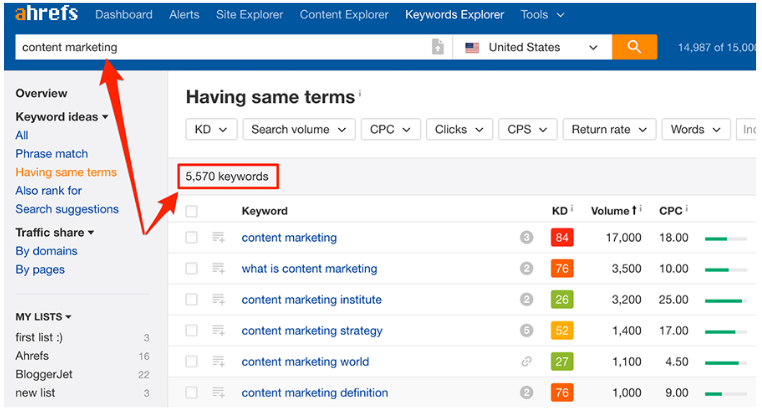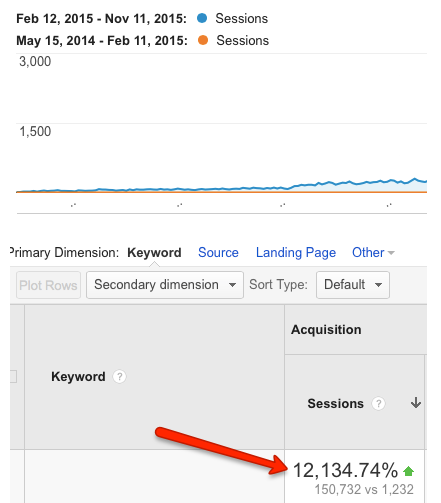One of them is a Google algorithm change which usually hit many unsuspecting webmasters.
There are other factors that result in a traffic drop. It is easy to panic. You could even be unsure of what to do since there are many possible causes of this problem.

However, you “still” need to take action. Because you can’t afford to lose all the precious organic traffic to your website.
This post is going to show you some steps you can take to fix this problem.
Step #1: Reexamine your keyword strategy
One of the most important steps to rank high on search engines is to have a sound keyword strategy. But your keyword strategy should never be stagnant.
Because search engine users’ behaviors change with time. Are users still searching for the keywords you’re trying to rank for?

Your keyword strategy involves conducting keyword research and selecting keywords that are important to your business.
This ‘strategy’ will also depend on the goals you want to achieve with your website.
Is it more sales or brand visibility?
There are some tools you can use to aid your keyword strategy. These are:
i). Google Search Console: With this tool, you can see keywords that you’re already ranking for. You can also see those that are close to the top ten on the search results page. This can give you insights on posts to improve to increase your ranking.
You can also use this tool, along with Google Analytics to track the success of your strategy. With this, you’re also aware of errors on your website.

ii). Ubersuggest: You can enter your main keywords in this tool and it will give you different variations, their competitions, and cost-per-click (CPC) if you want to advertise.

iii). Google Keyword Planner: This is a tool available to you if you use the Google Ads platform. It gives you details like volume and CPC of a given keyword.

iv). Ahrefs: This is one of the most popular tools for keyword research. You can also use this tool for competitor research to see the backlinks your competitors have built.

With industry analysis and keyword research, Maldives Traveller increased visits from competitive keywords “Holiday Resorts Maldives” by 453% and keywords in position 1 to 3 also increased from 0 to 20.

Step #2: Check your lost links and your link profile
Building backlinks is one practice that can get your content a higher rank in the search engines. In fact, Google’s Search Quality Senior Strategist, Andrey Lipattsev rates backlinks along with the quality of content and RankBrain as the 3 most important factors to rank on Google.
Links show that other websites trust your content and they’re willing to pass a bit of authority to your page. There are many reasons you could lose links. Some of them are:
i). Broken links (error 404): This could occur when you move your website from one host to another or change your website domain name or URL.
Visitors who click through to your website from another website will not see the page they’re looking for. Sadly, they will see a 404 error page which is similar to this:

Over time, the referring website may have to remove the link and replace it with your competitor’s as yours is no more providing value for their users.
ii). Outdated content: Things change fast on the internet. Content that was useful 2 years ago may be outdated now due to new developments. Websites that link to you look out for their users first and won’t hesitate to replace your page with an up-to-date post.
What can you do when you notice this? Improve your content with current information. Period!
iii). Find broken links: With tools like Google Analytics, Moz Analytics, or Ahrefs, you can find broken links on your website and perform a permanent redirect 301.
iii). Update your content: When you have posts that rank high for your ideal keywords, you must be aware that other websites are working to outrank your website. Regular updates with new developments will make sure you stay ahead of the competition.
One other thing you need to check on your link profile is the number of backlinks in comparison to the number of referring domains.
If you have 1 million backlinks from 1,000 domains, you could incur Google’s penalty because it seems unnatural. 50,000 domains probably look better (and more natural) with that number of links.
By creating valuable and helpful content, analyzing, and building more quality links to his website, Felix Tarcomnicu was able to increase organic traffic to his website by 210%.
Step #3: Did the drop coincide with a major site change?
If you made any major change to your website a few days or weeks before the organic traffic drop, then you need to look in that direction. Did you change your domain name? Or moved your blog from a subdirectory to a subdomain?
Did you change your website theme? When you see an organic traffic drop, this is the first thing to consider. A major change on your website could have been the cause for your organic traffic drop.
For instance, when IWantMyName moved their blog from a subdirectory to a subdomain on their website, they noticed a traffic drop.

In this case, they knew that this was the only major change they had made to the website recently that could cause the problem. They quickly reverted the change to solve the problem.
Step #4: Check if your website has duplicate content
When you have duplicate content on your website, it can be confusing to search engines. They don’t know which version to show in search results and they may remove the page totally from the search results page.
Another way your website could have duplicate content is if you copy a post from another website. It could also happen if you have your posts on more authoritative websites.
These posts are more likely to rank than the version on your website as these websites have a better authority than yours.
Step #5: Create a relevant 404 error pages
When visitors land on a 404 error page on your website, they have failed to find what they’re looking for. Sadly, it’s a bad user experience.
Most times, these visits result in a bounce, which is not good for your website.
To reduce the bounce rate on your 404 page, you should improve the page design and include relevant links to your blog homepage and other important pages on your website.
Below is an example of an error 404 page on CloudSigma. The page incorporates humor and also provides a link to the homepage.

Step #6: Check and improve the quality of your content
When you see a drop in organic traffic, it could be because other websites have produced resources better than yours. The competition to rank for important keywords is getting tougher daily.
You need to check if your content provides value. How? You need to make sure that your content answers all the current and important questions that your visitors may have on that topic.
Another way to improve the quality of your content is to write headlines and meta descriptions that attract readers to click-through to your website.
To improve your SEO performance, you need to look at the title tag and meta description that appears in the search results. Does it show potential benefits to searchers?

Your meta description is the snippet that gives more details about your post on the search engine results page.
If you don’t set a meta description, Google or Bing or any other search engine will simply lift random sentences from your post as your meta description.
This may not be what you want searchers to see. Likewise, it could reduce your click-through rate which may lead to a loss in ranking position. You can use the Yoast plugin to edit the meta description of your posts if you’re on WordPress.

By creating quality content and adding other marketing strategies such as influencer marketing and social media, Michael Karp increased organic traffic to his UAV Coach website by 12,134% in 18 months.

Step #7: Improve your business listing on Google Map
Do you have a local business and you want searchers in your locality to easily find your business, contact you, and buy your products and services?
One of the most important steps you can take is to register your business on Google My Business listing. But not only that.
Just creating your listing won’t make you automatically get leads for your business. You also have to include important details and optimize your business listing for search.
You have to optimize for keywords that show purchase intent in searchers. For your business listing, you have to include the most important details like the address of your business, telephone number, opening hours, and images of your business location.
Another thing you can add to your listing is posts. Google even gives you the template to release promotional offers and information about events in your business.

Apart from this, you can also use the posts to update your customers about important information they need to know about your business.
Even though your posts will only last about 7 days, you should search regularly as this helps you to rank for local searches.
Ranking for these searches is vital. ThinkWithGoogle found that at least 4 in 5 consumers perform a local search on search engines and more than half of searches on the go (56%) and in-store (51%) have local intent.
Likewise, 50% of smartphone users and 34% of computer/tablet users who perform a local search usually visit a physical store within a day.

Conclusion
Although getting a huge amount of organic traffic might seem like a lot of hard work and many actions on your website, which is true. But it’s not rocket science. It’s totally doable.
You need to be able to observe the current trends and adapt to the needs of your visitors. Your website should be a source of solution for your visitors and this would prevent search traffic drops, and of course, improve your rankings.
Follow the steps highlighted in this post and you can expect a rise in your website organic traffic.



